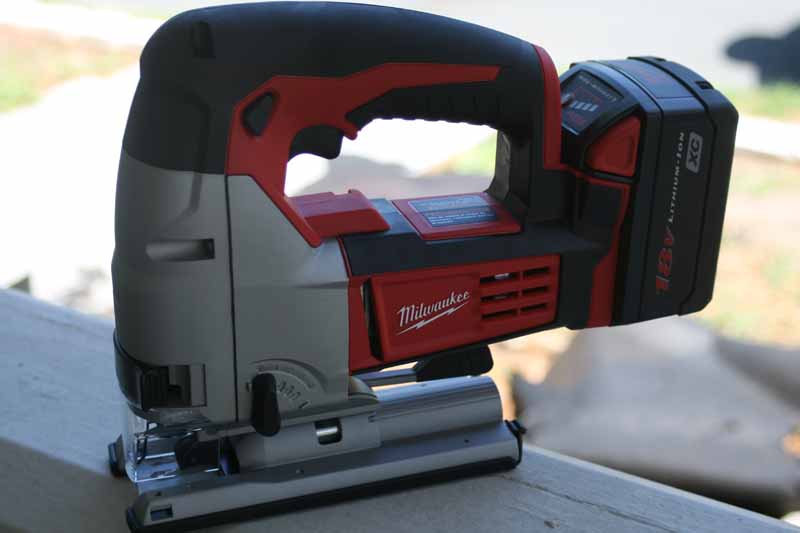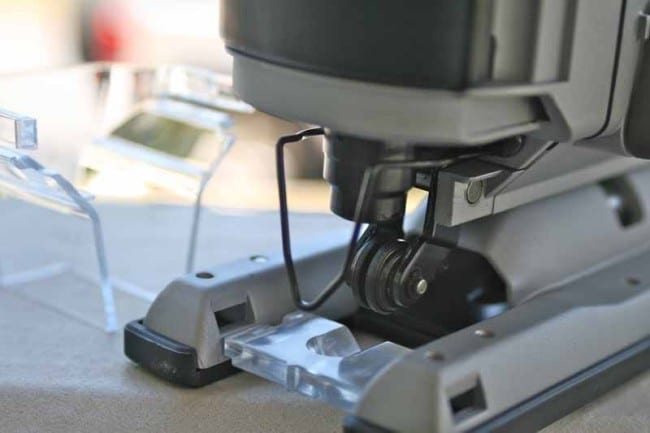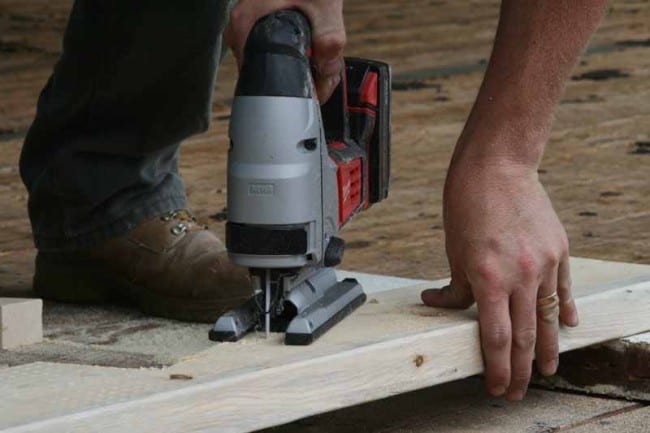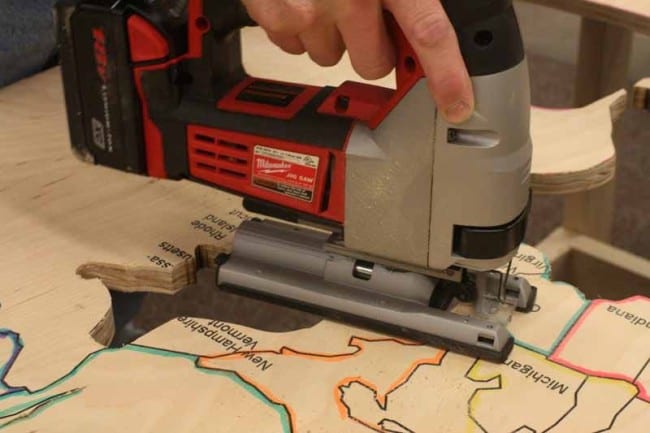A jigsaw is one of those tools that, once you get used to using it, you never want to reach for a substitute. It’s also the kind of tool where a little heft isn’t such a bad thing, and build quality really contributes to both usability and control. When Milwaukee issued its cordless version of their already robust 6268-21 jig saw, we wondered if it would hold up to the rigors of serious jobsite abuse. It turns out that the Milwaukee M18 cordless jigsaw (2645-22) is more than up to the task of taking on even larger scale jigsaw jobs.
The 2645-22 is Milwaukee’s first lithium ion-powered cordless jig saw and it benefits immensely from the additional power-to-weight offered by the format. What you get is a lot more run-time and power for the same amount of weight. In addition, the tool runs at near-full power until the battery runs out, giving you a longer time to tackle even the toughest projects.
Milwaukee M18 Cordless Jigsaw Build Quality
The first thing you’ll note about the Milwaukee M18 cordless jigsaw is its heft. At just under 8 pounds, this isn’t some lightweight jigsaw you can pick up at Wal-mart for $20. The difference is significant. What professional contractors and journeymen know, and what casual users may not, is that heft in a jigsaw provides much more control and stability. With this Milwaukee Jig Saw, we noticed immediately that it felt solid in the hand and wouldn’t be bounced around by the action of the blade. This also meant that even though it offered a significant orbital action, the blade would be kept under control by the eight pounds of metal and plastic bearing down upon the working surface.
The weight is also distributed in a near-perfect manner. Holding the tool with your middle finger just below the trigger, you can suspend the tool in a perfect balance, the blade exactly perpendicular to the cutting surface (with one of the M18 XC batteries installed). This means that the tool is always working with you to make the cut, not attempting to leverage against the wood or cause the balance to be forward or aft of the shoe.
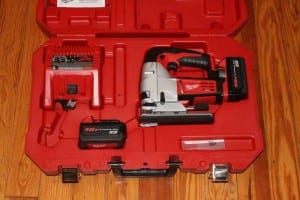 The Milwaukee M18 cordless jigsaw comes with an oversized blow mold case, two M18 XC lithium-ion batteries, the 2645-20 jig saw tool and a charger. What we quickly noted was that you could store the jig saw in the case with a blade inserted. In this way it’s ready to go when you are. In addition, there was ample storage for additional blades, something we made use of right away. We’ve come to like the Milwaukee cases for several reasons: 1) they include metal latches which are easily fastened and unfastened, 2) they typically give you extra room inside the case to store accessories and support cords and cables, and 3) they secure the tools safely and efficiently.
The Milwaukee M18 cordless jigsaw comes with an oversized blow mold case, two M18 XC lithium-ion batteries, the 2645-20 jig saw tool and a charger. What we quickly noted was that you could store the jig saw in the case with a blade inserted. In this way it’s ready to go when you are. In addition, there was ample storage for additional blades, something we made use of right away. We’ve come to like the Milwaukee cases for several reasons: 1) they include metal latches which are easily fastened and unfastened, 2) they typically give you extra room inside the case to store accessories and support cords and cables, and 3) they secure the tools safely and efficiently.
The jig saw itself is in the expected Milwaukee colors, with the no-slip black rubber overmold in the usual places. There is a safety trigger lock that prevents the trigger from moving, however this is an always on, always off lock, not the kind that needs to be depressed with every use of the trigger. The concept is to be able to lock the tool when it is being stored or a blade is being changed (though Milwaukee also wants you to remove the battery whenever servicing or adjusting the tool). It’s a practical mechanism and never got in our way. The tool comes with a shoe cover which is perfect to keep the aluminum plate from scratching softer wood surfaces or metals. It stores pretty neatly in the pocket of the blow mold case designed to secure the user manuals. There is also a clear, anti-splinter guard that can be slid into the shoe to help make smoother cuts. This device is meant to be used on straight cuts only and with no orbital action. A transparent blade cover (removable) also offers some more protection and does so without really interfering with your line of sight.
 A rear-oriented shoe adjustment lever slides to the side to allow for the shoe to be pulled forward and tilted to any of seven different positions. Once the position lock is fitted to an available detent, you can pull the shoe back into position and slide the adjustment lever back to lock it into place and prevent further adjustment. The range of bevel/angle is 45 degrees. Since there are a total of seven detents, that means you can adjust to 0, 15, 30, and 45 degrees in either direction with relative ease. You can also, of course, set the shoe to any required bevel angle by simply locking it down without allowing it to move back into a detent before re-securing the lever.
A rear-oriented shoe adjustment lever slides to the side to allow for the shoe to be pulled forward and tilted to any of seven different positions. Once the position lock is fitted to an available detent, you can pull the shoe back into position and slide the adjustment lever back to lock it into place and prevent further adjustment. The range of bevel/angle is 45 degrees. Since there are a total of seven detents, that means you can adjust to 0, 15, 30, and 45 degrees in either direction with relative ease. You can also, of course, set the shoe to any required bevel angle by simply locking it down without allowing it to move back into a detent before re-securing the lever.
The orbital action is controlled by a selection lever mounted on the left side of the tool. As logic would have it, straight up and down is no orbital action and if you pull it back to the horizontal position you get the most orbital movement offered (which is a reasonable amount and not so much as to make the tool lose control or become unwieldy). We poured on the orbital action for our rafter project (more on that later) and dialed it back to zero on more delicate woodworking applications.
Changing blades is easy. The front-mounted Quik-lok tension lever simply swings to the right and allows the tool’s plunger to release the lugs on the t-shank blade. It took us on average about 3 seconds to change blades – it is literally that fast and no tools are required.
Milwaukee M18 Cordless Jigsaw Testing and Use
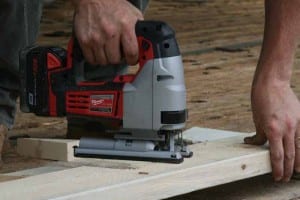 Using a cordless jig saw is freeing. We were able to take this tool onto the roof with us during a recent project in which we recut over 40 rafter tails to match the profile of an existing 1920’s home. The extra heft of the tool did wonders in stabilizing it during cuts through 2×6 dimensional lumber in order to notch it out to fit onto the load-bearing outside walls. We found that, setting the tool down on top of the 2×6, the extra heft really made the cuts simple. The blade wouldn’t dance around and the tool simply felt like it was more than capable of powering through the thick wood without any difficulty. The orbital action also helped us in making quick work of these cuts. Without it, the blades would have had a lot harder time powering through all that pine. This is a much different experience than what you get with a cheaper, plastic corded jigsaw. It was surprising to see that Milwaukee could put out a cordless jig saw that rivaled a lot of corded models we’d used in the past. Of course, for $350, we would expect no less.
Using a cordless jig saw is freeing. We were able to take this tool onto the roof with us during a recent project in which we recut over 40 rafter tails to match the profile of an existing 1920’s home. The extra heft of the tool did wonders in stabilizing it during cuts through 2×6 dimensional lumber in order to notch it out to fit onto the load-bearing outside walls. We found that, setting the tool down on top of the 2×6, the extra heft really made the cuts simple. The blade wouldn’t dance around and the tool simply felt like it was more than capable of powering through the thick wood without any difficulty. The orbital action also helped us in making quick work of these cuts. Without it, the blades would have had a lot harder time powering through all that pine. This is a much different experience than what you get with a cheaper, plastic corded jigsaw. It was surprising to see that Milwaukee could put out a cordless jig saw that rivaled a lot of corded models we’d used in the past. Of course, for $350, we would expect no less.
Noise wasn’t terrible, but the tool did come in at around 93 db SPL during our noise tests (measured from 36″ away). Expect this to go up when engaging actual wood (our tests are done with just the tool so we can be consistent). Hearing protection is simply a good idea when you are using power tools for an extended period of time. This is especially true for woodworking professionals, both in- and outdoor, who may suffer hearing loss from long-term exposure to power tools.
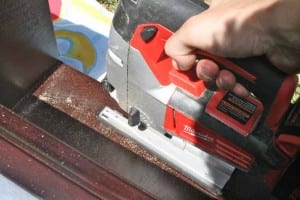 For a more delicate project we took the hutch for a new writing desk and cut a simple rounded beveled notch out of the base with which we planned to make room for the cabling for a small Mac Mini. This kept us form having to cut a hole into the top surface of the desk and produced a great solution that was perfect for a jig saw. Laying the hutch on it’s side, protected by a towel, we drew out our cut in pencil and followed it with the Milwaukee M18 Cordless Jig Saw. We kept the saw straight and pulled back the orbital action to its 0 setting so as to not destroy the edges of the wood. While the anti-splinter guard would have been perfect for this job, we opted out to see how well a finer toothed wood blade would do without it. Turned out, the M18 2645-22 can be downright gentle when it needs to be, and our cut was soon completed, with a nice rounded profile and relatively smooth edges. We used the 18V jigsaw on several other projects throughout the review period, including cutting out a map of North America into its component states and territories. In each case it maneuvered easily and the additional weight afforded by the Milwaukee build quality added to the ease of use in making even very tight turns without vibrating the platform.
For a more delicate project we took the hutch for a new writing desk and cut a simple rounded beveled notch out of the base with which we planned to make room for the cabling for a small Mac Mini. This kept us form having to cut a hole into the top surface of the desk and produced a great solution that was perfect for a jig saw. Laying the hutch on it’s side, protected by a towel, we drew out our cut in pencil and followed it with the Milwaukee M18 Cordless Jig Saw. We kept the saw straight and pulled back the orbital action to its 0 setting so as to not destroy the edges of the wood. While the anti-splinter guard would have been perfect for this job, we opted out to see how well a finer toothed wood blade would do without it. Turned out, the M18 2645-22 can be downright gentle when it needs to be, and our cut was soon completed, with a nice rounded profile and relatively smooth edges. We used the 18V jigsaw on several other projects throughout the review period, including cutting out a map of North America into its component states and territories. In each case it maneuvered easily and the additional weight afforded by the Milwaukee build quality added to the ease of use in making even very tight turns without vibrating the platform.
Conclusion
The Milwaukee M18 Jig Saw is easy to use, built like a tank and will run for a good amount of time on a single XC battery – yet it comes with two. It’s a nice package and one that should appeal to professionals a bit more than the casual user, though only because of the cost of entry. This was a tough tool to rate due to its high price when purchased as a complete kit. What’s great to note, however, is that you can find the bare tool for around $129. If you’ve already got some Milwaukee 18V lithium-ion tools, this is going to be an impossible tool to pass up – it’s an incredible bargain. For those wanting to get the entire kit, the charger and additional XC batteries will do well to breath new and extended life into your existing tools, so it’s still a pretty good value (though we’d stop short of labeling it a “bargain”). For performance it was easy to give this jig saw a 9/10. It’s heavy, well-built, and you get the feel that it could take a tumble off a ladder and get right back up (unlike most construction workers I know). Tough to rate, but easy to recommend, the M18 Jig Saw from Milwaukee is one that is almost certain to please.

